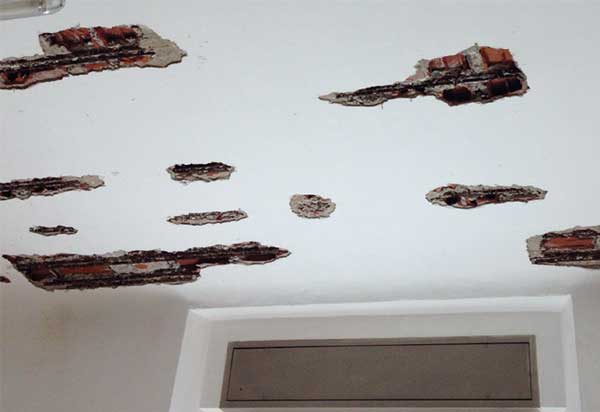Ceiling anti-shatter protection
Systems for securing slabs and architectural surface coatings.
The phenomenon of shatter and falling of ceiling fragments
“Shatter and falling of ceiling components” is defined as the condition where the lower panels of the lightening blocks inserted in the mixed concrete beam and block floor (slabs made of concrete joists and infill blocks or bricks) become detached and then fall. These blocks may be used exclusively for lightening or they may also play a structural role.
Irrespective of whether they are used simply for lightening purposes or form an integral part of the building structure, these lightening blocks may constitute a hazard for persons or property in the event they are damaged or collapse, even partially.
The possible causes of shatter and falling of ceiling fragments, on cast-in-place slabs include:
– poor workmanship, in particular, the presence of steels bars positioned on the bottom of the joist in contact with the brickwork, resulting in an irregular and discontinuous concrete cover;
– elevated grain size of the aggregates present in the concrete with respect to the geometry of the joist, together with a failure to vibrate the concrete correctly (or at all) when casting;
– misalignment of the vertical piers of the blocks, resulting in a concentration of stresses in the nodes, which, unable to transmit them to the horizontal piers, damaging the lower panels and causing them to collapse;
– design errors, such as excessive differences between slab spans, which may cause entire portions of the shorter slabs to collapse (“arch” effect). Or beam spans similar to those of the slabs which may trigger “plate” mechanisms that are difficult to evaluate ‘a priori’.
– phenomena attributable to external actions or events occurring during the service life of the construction, such as water leaks, the presence of unforeseen loads, etc.


Diagnosis and procedures for repairing slabs
Before carrying out any repairs, it is necessary to perform a complete analysis on the affected slab. In particular, it is important to identify any data relating to the original project (for example by consulting the manufacturer’s catalogues/data sheets).
If possible, identify any gaps or imminent collapses by tapping, thermal imaging or Sonreb testing.
It is also necessary to assess the degree of deterioration of the joists (and, in particular, the reinforcements) and the presence of the collaborating top concrete slab above the lightening blocks.
If the joists are not suitable, it is advisable to brush the bars, treat them with cementitious PASSIVATOR and restore the concrete cover using suitable concrete restoration mortars, such as MX-R4 Repair, a concrete repair mortar certified in accordance with UNI EN 1504-3.

If it is necessary to strengthen the reinforcement, it is possible to intervene (without increasing the weight) using structural strengthening with FRCM composite materials, consisting of PBO-Mesh 105 series PBO meshes together with MX-PBO Concrete cementitious adhesive matrix. When using a passive ceiling anti-shatter system, it is fundamentally important to assess the condition of the joists in order to determine whether the concrete is capable of retaining the mechanical anchors. If not, it will be necessary to insert the anchors into the collaborating top concrete slab above the brickwork in a sort of hanging arrangement, using threaded “dry” expansion systems so as not to disturb the joists (especially in the case of reduced sections).


Example of slab with bottom removed and volumetric reconstruction of the joist with MX-R4 Repair mortar
Example of slab with rebars exposed and passivated with Ruregold Passivator, joist with FRCM strengthening with PBO-Mesh 105 and MX-PBO Concrete inorganic matrix.
Ruregold solutions
Thanks to over 10 years experience in the field, Ruregold, has developed and certified three complete systems, offering a solution for every on-site need. Each system consists of meshes, fastening systems and plaster mortars, all characterised by ease of application and secure performance.
Passive and active protection systems
Protection systems are classified as active or passive, depending on the function they are required to perform:
- "Passive" protections: these are safety systems designed to the brickwork from falling and compromising the safety of people once it has become detached. Unlike “active” protections, these systems “contain” the element, rather than prevent it from becoming detached.
The Ruregold "passive" protection against detachment of ceiling fragments is the STUCANET system. - "Active" protections: these are safety systems designed to prevent the lower panels of the lightening blocks from becoming detached, and subsequently falling. The Ruregold “active” ceiling anti-shatter protection solutions are: SAFENET and ARMANET.




SafeNet offers the highest performance, as well as being quick and simple to install.
StucaNet is specifically designed for use on badly shattered or fallen slabs because it can be applied without preparing the support.
The traditional, ArmaNet system features a galvanised mesh and may even be dry-laid.
Certifications
All Ruregold protection systems have been subjected to experimental trials designed to assess their behaviour under ceiling shatter and falling load. Thanks to the support of qualified laboratories, it was possible to certify the performance of the three systems, with and without plaster:
■ SafeNet: certified at the Milan Polytechnic at overloads of 500 kg/m2 (plastered system) and 250 kg/m2 (unplastered system), with various anchor point distribution patterns and the possibility of hanging loads (such as lights and functional elements).

■ StucaNet: certified at the SidLab laboratory for behaviour under ceiling shatter and falling load of up to 300 kg/m2 with various anchor point distribution patterns and the possibility of hanging loads (such as lights and functional elements) and up to 50 kg per single hanging point.

■ ArmaNet: certified at the SidLab laboratory for behaviour under ceiling shatter and falling load of up to 130 kg/m2, with various anchor point distribution patterns and the possibility of hanging loads (such as lights and functional elements).








